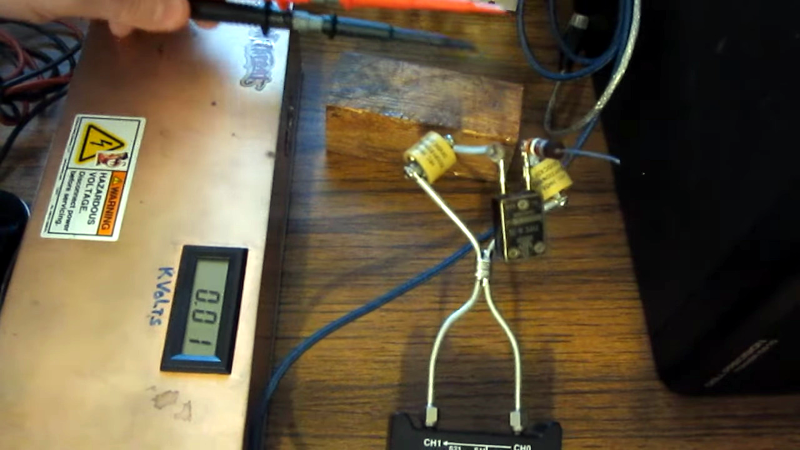Do high voltages affect the resonant frequency of a crystal? Honestly, we never thought about it, but [Joe] did and decided to risk his analyzer to find out. He started with some decidedly old-school crystals like you might have found in a 1960-era Novice rig. Since the crystal is piezoelectric, he wondered if using a high DC voltage to bend the crystal to move the frequency to create a variable crystal oscillator (sometimes called a VXO).
He created a rig to block DC away from the network analyzer and then feed voltage directly across the crystal. The voltage was from an ESD tester that provides over 1000 volts.
Getting a crystal to change much in frequency is difficult, which is why they are useful. So we weren’t surprised that even at very high voltages, the effect wasn’t very large. It did change the frequency, but it just wasn’t very much.
At one point, it looked like he might have killed the test equipment. There was a time when letting the smoke out of a network analyzer would have been a costly mistake, but these days the cost isn’t that prohibitive. In the end, this experiment probably doesn’t produce any practical results. Still, it is interesting, and we always enjoy watching anything that gives us more intuition about the behavior of circuits or, in this case, circuit elements.
If you need a refresher on crystal oscillators, we can help. There are other ways to modify a crystal’s frequency, of course.

















Interesting experiment, but a variable capacitor across … or in series with … the crystal works a lot better.
Yup, I used to ” Rubber” a crystal back in my novice days with a cap/inductor. Man, that was a long time ago .
For varying xtals frequency it is better to use only series capacitors and inductors; a series capacitor will raise the oscillation frequency while an inductor will lower it; by putting a fixed inductor and a variable capacitor in series with the crystal one can adjust the frequency both above and below the nominal xtal one. This technique is called xtal pulling, there’s some good information about it online.
The Russians did an interesting experiment where they made a huge piezoelectric crystal that weighed several tones, they then applied a layer of plastic explosives, and a thin protective buffer layer to the top side of the crystal, and detonated the explosives. The resulting voltage pulse generated by the crystal was hundreds of millions of Volts. One of the highest man made voltages ever made.
Looking in the kitchen cupboard, thinking I’m going to need some more cream of tartar and bicarbonate of soda.
I’d have liked to have watched that experiment.
No doubt it would be vry tricky to grow a monolithic crystal that large.
No doubt the crystal didn’t see a second experiment.
It reminds me of explosive coil compression that generates large currents.
I might be under the mistaken belief that large voltages causes a crystal to move so much that it fractures, or that’s what my experience says
I still remember the days of putting a dot of marker pen or varnish on the crystal to change the frequency.
I remember grinding crystal blanks from military FT-243 holders on a glass plate using Ajax abrasive soap powder and water to form a paste. I could move a crystal pretty far if I was careful. I still have some of those crystals … can’t bring myself to throw them away.
So high V gives you a VCO?
TL;DR: 1.4 kV changed the resonant frequency about 7 Hz, or 2 ppm.
The test jig was not properly designed to protect the test equipment.
The use of ceramic capacitors to provide DC blocking is a mistake; ceramic capacitors have a voltage coefficient of capacitance (although these look to be very old capacitors, which are likely not high-K and therefor would not have a large voltage coefficient of capacitance). The voltage-induced change in capacitance would change the resonant frequency of the circuit.
DC current through a torroidial inductor will change it’s inductance enough to be a useful hack for remotely tuning a loop antenna…